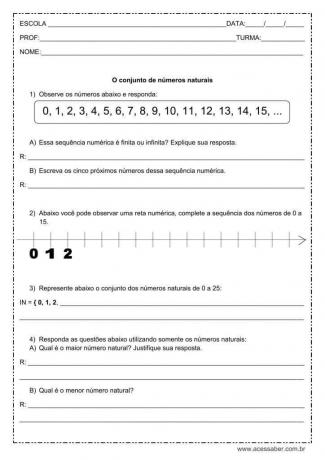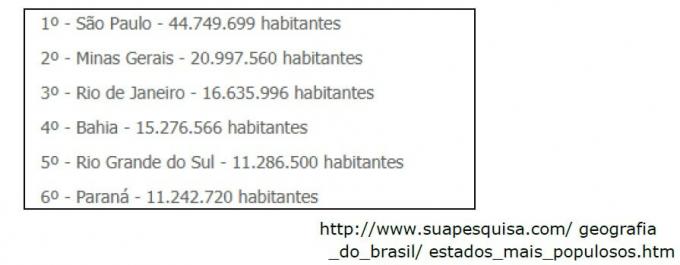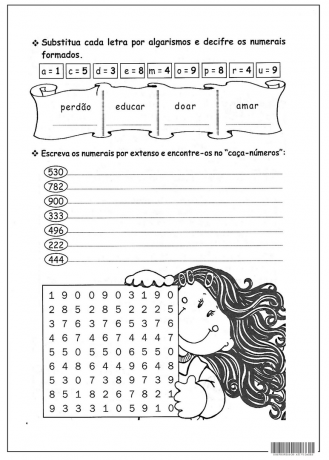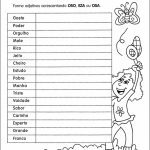We decided to select some activities on natural numbers for the 4th, 5th and 6th grade. That way, teachers can apply them in the classroom or as homework. The latter can allow students to continue practicing even when they are not in the classroom.
Now teachers can take advantage of all the tips below.
Numbers in everyday life.

1) Write the number that appears in the table below as you read:
 A:
A:
2) See below a table with the population of the six most populous states in Brazil, according to IBGE 2016 estimates.

a) What are the three most populous states in our country?
A:
b) And which is the most populous state in the Northeast of Brazil?
A:
c) Write in full the number that represents the population of the 6th (sixth) largest state in Brazil.
A:
3) At the “Manolo Antunes” school there was a scavenger hunt to commemorate student week. Students were divided into three large teams. The tests were divided into three stages. Below is the table with the names of these teams and their respective points in each stage.

a) How many points did the red team score in the three stages?
A:
b) How many points did the blue team score in the three stages?
A:
c) How many points did the black team score in the three stages?
A:
d) So which team won the competitions?
A:
e) What is the difference in points between the red and black teams? Write it out in full.
A:
f) Write in full the sum of the points obtained by the three teams.
A:
4) When Walter was born, his father was 28 years old. Currently, Walter is 18 years old. Determine the sum of the ages of Walter and his father today.
A:
5) Analysis:
The smallest of three consecutive numbers is 550. Determine the sum of these numbers.
A:
6) Now determine the sum of all three different digit numbers that can be formed with digits 3,4 and 5.
A:
Mathematics can be one of the most complicated subjects for students. So, the teacher needs to convey the concept of each subject in a clear and simple way. Therefore, we selected some math activities about natural numbers that can be applied to 4th grade students.
Take advantage of the tips and make your math lessons as easy as possible. Oh, don't forget to give homework, this keeps students practicing outside of the classroom.

1) Look at the numbers below and answer:
0, 1, 2, 3, 4, 5, 6, 7, 8, 9, 10, 11, 12, 13, 14, 15, …
A) Is this numerical sequence finite or infinite? Explain your answer.
A:
B) Write the next five numbers in this numerical sequence.
A:
2) Below you can see a number line, complete the sequence of numbers from 0 to 15.
0 1 2
__|__|__|__|__|__|__|__|__|__|__|__|__|__|__|__
3) Represent the set of natural numbers from 0 to 25 below:
IN = {0, 1, 2,
4) Answer the questions below using only natural numbers:
A) What is the greatest natural number? Justify your answer.
A:
B) What is the smallest natural number?
A:
5) Fill in the gaps with the successor:
a) 43 =
b) 26 =
c) 31 =
d) 12 =
6) Fill in the gaps with the predecessor:
a) 15 =
b) 22 =
c) 36 =
d) 45 =
7) Using the figures indicate the quantities:
a) Thirteen =
b) Fifty-seven =
c) One hundred and forty-four =
d) Eight hundred and thirty-eight =
8) Replace the letters with the numbers in the table below and see which numbers can be formed
| L | THE | R | T | O | Ç | s | AND |
| 2 | 3 | 5 | 1 | 4 | 7 | 6 | 8 |
The words are:
a) Home =
b) Mouse =
c) Home =
d) School =
9) Write in full:
a) 743
b) 124
c) 1431
d) 3831
e) 875
f) 296
g) 4539
10) In the table below, complete with the following numbers:
a) Two thousand one hundred and thirty four
b) Eight hundred and twenty-nine
c) Three thousand and forty-eight
d) One thousand nine hundred and eighty-three
e) Three hundred and twelve
f) Four thousand seven hundred and seventy-eight
| One | Ç | D | U |
The)
B)
ç)
d)
and)
f)
11) Write down seven numbers consisting of three digits.


Did you like it? Share this post on your social network
 ADJECTIVE ACTIVITY IDEAS
ADJECTIVE ACTIVITY IDEAS
 ACTIVITIES WITH THE USE OF THE WHY
ACTIVITIES WITH THE USE OF THE WHY
 ACTIVITIES WITH DECIMAL NUMBERS
ACTIVITIES WITH DECIMAL NUMBERS
 Food Chain Assessment Activities 4th 5th 6th Year
Food Chain Assessment Activities 4th 5th 6th Year
 MATHEMATICS ACTIVITIES WITH ORDINAL NUMBERS
MATHEMATICS ACTIVITIES WITH ORDINAL NUMBERS
![Science Descriptors Elementary School [COMPLETE]](/f/49b52b38501cfe470e8f5201ad1eceb3.jpg) Science Descriptors Elementary School [COMPLETE]
Science Descriptors Elementary School [COMPLETE]
This site uses Akismet to reduce spam. Learn how your comment data is processed.
